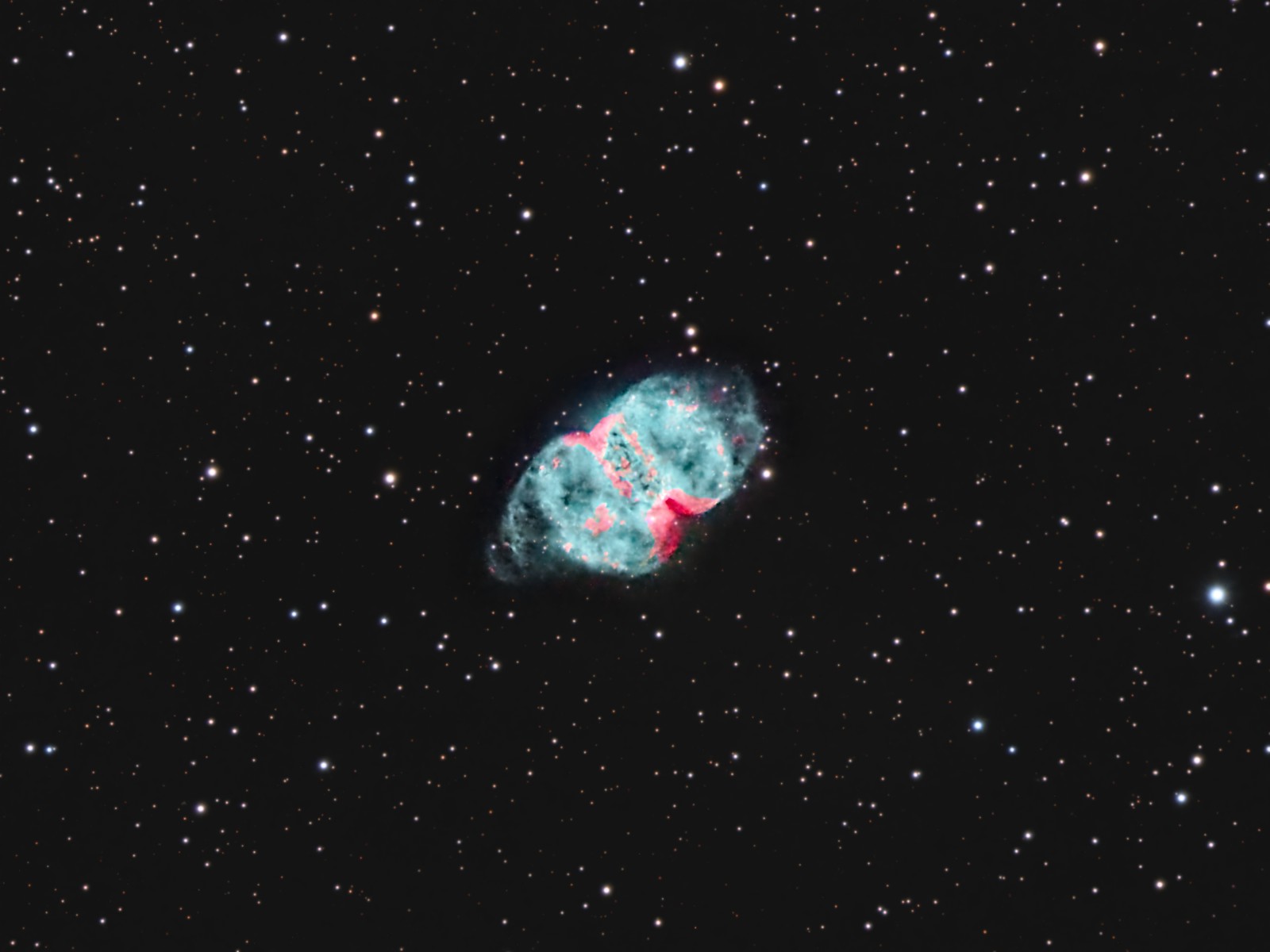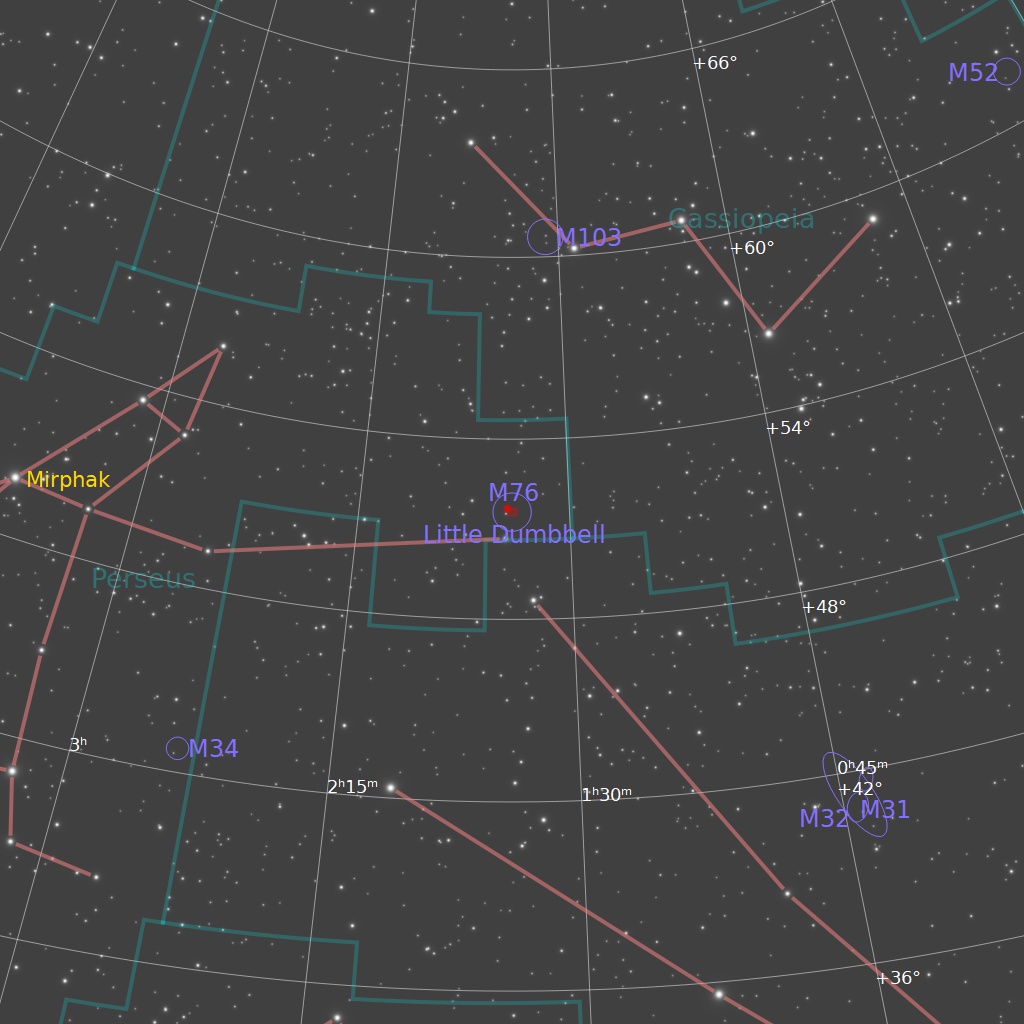M76, The Little Dumbbell Nebula
Click image for full size version
September 25, 2023
This is M76, also known as the Little Dumbbell nebula, and it is the faintest object in the Messier catalogue (but still visible in binoculars in a dark sky). It’s nickname is a nod to the bigger, brighter showpiece object, the Dumbbell Nebula (M27). Both of these planetary nebulae glow because gas thrown off by a dying central star is now absorbing the dying star’s energy and re-emitting it as visible light. Hydrogen accounts for the red; oxygen for the blue-green. M76 is located in the constellation Perseus around 2,500 light years distant. Nebulae of this type dissipate over a period of thousands of years. The term “planetary nebula” has nothing to do with planets. Early telescope observers saw these objects as being disc-like, sort of like planets, and gave them this name. I have imaged M76 previously, but always thought I could do better with the addition of narrowband data. That, and a longer focal length, are the reason the new image shows much more detail in the core, and faint extensions on both ends.
Tekkies:
Acquisition, focusing, and control of Paramount MX mount with N.I.N.A., TheSkyX and PHD2. Primalucelab low-profile 2″ Esatto focuser and ARCO rotator. Equipment control with PrimaLuce Labs Eagle 4 Pro. All pre-processing and processing in PixInsight. Acquired from my SkyShed in Guelph. Below-average transparency and above average seeing. Data acquired September 23-24, 2023 under a nearly moonless sky.
Celestron 14″ F/11 EDGE HD telescope at f/11 (3,912 mm focal length) and QHY600M camera binned 2×2 with Optolong filters.
10x5m Red = 0hr50m
10x5m Green = 0hr50m
12x5m Blue = 1hr00m
29x5m Ha = 2hr25m
36x5m O3 =3hr00m
Total: 8hr15m
Preprocessing: The WeightedBatchPreProcessing script was used to perform calibration, cosmetic correction, weighting, registration, local normalization and integration of all frames.
Colour master: A colour master was made from the Red, Green and Blue masters using ChannelCombination in RGB mode.
Gradient Removal: DynamicBackgroundExtraction was applied to the RGB, Ha and O3 masters.
Colour Calibration: SpectrophotometricColorCalibration was used to calibrate the RGB master.
Deconvolution: BlurXterminator was used on the Ha, O3 and RGB masters with Automatic psf , and star sharpening set to 0.10 with “Correct First” selected. The same settings were used with Automatic PSF on the Color image.
Addition of Ha and O3: The NBRGBCombination script was used to combine the Ha and O3 with the RGB using default settings except for NB bandpass (3nm for both Ha and O3).
Linear Noise Reduction: NoiseXterminator was applied to the NBRGB image with settings Amount=0.9 and Detail=0.15
Star Removal: StarXterminator was used to remove the stars, with default settings.
Stretching: HistogramTransformation was applied to the NBRGB master to make a pleasing image. Approximate background level after stretch was 0.10.
Nonlinear Processing
Nonlinear Noise Reduction: NoiseXterminator was used to reduce noise in the background areas of the image with settings Amount=0.9 and Detail=0.2
Re-stretch: HistogramTransformation was used to boost contrast by moving the dark point to the toe of the histogram and slightly decreasing the mid-point slider.
Contrast Enhancement: HDRMultiscaleTransform was applied twice (scale 6 and 4) using a mask to select just the core of the nebula. LocalHistogramEqualization was applied twice using a mask to select the entire nebula. A Contrast Limit of 1.5 and 1 iteration was used for each LHE application (scale 40, strength 0.5; scale 90, strength 0.5; scale 150, strength 0.5).
Sharpening: The mask used for LHE was used for sharpening with MultiscaleMedianTransform (Layers 1 – 5 with strengths of 0.01, 0.03, 0.05, 0.05, and 0.01, respectively).
Stars-only steps: MorphologicalTransformation was used in Morphological Selection mode to shrink the stars through a mask made by extracting the Luminance from the stars-only image. CurvesTransformation was used to add saturation to the stars.
Star Restoration: PixelMath expression combine(starless, stars, op_screen()) was used to combine the starless and stars-only images created with StarXterminator.
Final Steps: Background, nebula and star brightness, contrast and saturation were adjusted in several iterations using CurvesTransformation with masks as required. ICCProfileTransformation (sRGB IEC61966-2.1; Relative Colorimetric with black point compensation) was applied prior to saving as a jpg. The finder chart was made using the FindingChart process.








I love the way you explain the processing. Everything you need to know, nothing you don’t.